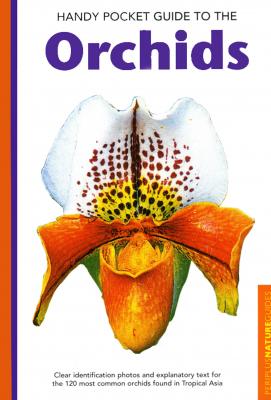Handy Pocket Guide to Orchids. David P. Banks
Читать онлайн.| Название | Handy Pocket Guide to Orchids |
|---|---|
| Автор произведения | David P. Banks |
| Жанр | Биология |
| Серия | Handy Pocket Guides |
| Издательство | Биология |
| Год выпуска | 0 |
| isbn | 9781462907274 |
HANDY POCKET GUIDE TO
Orchids
Rhynchostylis retusa
Published by Periplus Editions (HK) Ltd. with editorial offices at 61 Tai Seng Avenue #02-12, Singapore 534167.
Copyright © 2003 Periplus Editions (HK) Ltd.
ALL RIGHTS RESERVED
Printed in Singapore.
ISBN: 978-1-4629-0727-4 (ebook)
About the Author
David P. Banks has been growing orchids for over 25 years. He is a Past President of the Orchid Species Society of New South Wales, and of the Parramatta and District Orchid Society, and has also served two terms as Vice President of the Orchid Society of New South Wales. He is a qualified orchid judge with the OSNSW as well as the Australian Orchid Council and is the current Editor of The Orchadian and the Australian Orchid Review. Davids acclaimed photographs appear in many journals and he lectures extensively throughout Australia and overseas at workshops, society meetings and orchid conferences.
Acknowledgements
Most of the orchids illustrated in this book were grown by the author. However, I wish to thank the following people for allowing me to photograph plants in their collections: Margaret Barrett, Kerrie Bennett, Adrian Browne, Jim Cootes, Howard Gunn, Ray Hill, Sandy Holmes, Barry Long, Bruce Lonnon, Bob McCue, Brian Milligan, Jim Neal, Andy Phillips, John Roberts, Ken Smart and Darryl Smedley. I wish to express thanks to my photographic mentor, David Titmuss and to Jim Cootes who read and commented on the manuscript. Finally, and most importantly, I would like to thank my parents, Lynette and Graeme, for their encouragement.
This book is dedicated to the memory of my late wife Jannine Louise Banks.
Distributors
North. America, Latin America & Europe
Tuttle Publishing, 364 Innovation Drive,
North Clarendon, VT 05759-9436 U.S.A.
Tel: 1 (802) 773-8930 Fax: 1 (802) 773-6993
Japan
Tuttle Publishing, Yaekari Bldg, 3rd Floor
5-4-12 Osaki, Shinagawa-ku, Tokyo 141-0032
Tel: (81) 3 5437-0171 Fax: (81) 3 5437-0755
Asia Pacific
Berkeley Books Pte Ltd., 61 Tai Seng Avenue,
#02-12, Singapore 534167
Tel: (65) 6280 1330 Fax: (65) 6280 6290
[email protected] www.periplus.com
Indonesia
PT Java Books Indonesia,
Kawasan Industri Pulogadung
Jl Rawa Gelam IV No. 9 Jakarta 13930
Tel: (62) 21 4682-1088 Fax: (62) 21 461-0206
15 14 13 12 11 10
8 7 6 5 4
Contents
Amesiella and Ascocentrum
Bulbophyllum
Chiloschista
Coelogyne
Cymbidium
Dendrobium
Dendrochilum
Eria
Liparis
Paphiopedilum
Phalaenopsis
Renanthera and Rhynchostylis
Trichoglottis
Vanda
Introduction
Orchids have always held a fascination for people; there is an air of mystery surrounding them. Mention the word "orchid" and terms such as exotic, rare, expensive, beautiful, colourful and unique will arise. Everyone will have a different perception and all of these, no matter how diverse, will be correct.
Over 30,000 different orchid species are found on our planet, and well over 100,000 hybrid strains have been artificially propagated. Many of these hybrids are important commercial plants that are used as cut flowers and pot plants to satisfy strong demand, both locally and internationally.
What makes orchids different from other flowering plants? Their floral structure is obviously different. Orchids have three petals and three sepals which may, or may not, be alike. However, the third petal, known as the lip or labellum, is almost always highly modified and quite different from the other segments in size, shape and often colour. This structure often plays an important part in orchid pollination. Another feature, which helps to define orchids, is an appendage, known as a column, often located in the centre of the flower. The fleshy column combines the male (anther) and female (stigma) sexual parts on one structure. The anther and stigma are situated close together.
Orchid flowers use their form, colour and often fragrance to attract many creatures which act as pollinators. Bees, wasps, butterflies, moths, flies, beetles, ants and even birds assist the fertilisation of orchid flowers. Numerous orchid flowers actually mimic insects. Some deceive bees by looking like other flowers that offer a reward, while other species, often with deep maroon flowers, smell like rotten flesh, to attract flies!
Two main growth structures are found in orchids; monopodial and sympodial. Sympodial orchids, such as Bulbophyllum and Dendrobium, have a main stem, or pseudobulb, which is produced annually and matures at the end of each growing season, often culminating with flowering. During the next season, a new pseudobulb grows from the base of last season's growth. These pseudobulbs, which hold water and nutrients, are produced along a structure known as a rhizome. Monopodial orchids such as Aerides, Phalaenopsis and Vanda have main stems which grow constantly. These main stems produce flower spikes, correctly termed inflorescences, from or opposite the leaf axil.
Orchid seeds are minute and dust-like—a single fruit or capsule has the potential to produce up to a million seeds, depending on the species. However, orchid seeds have little food storage and rely on a specific type of fungus for their germination and development. The mortality rate in the wild is enormous. Now, orchid seeds are germinated in laboratories using a synthetic agar solution. This technique has made it possible to produce large quantities of both species and hybrids in a sterile environment. Depending on the genus, orchids can take from twelve months to twelve years from germination to
